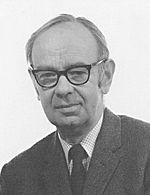Alan Robertson (geneticist) facts for kids
Quick facts for kids
Alan Robertson
|
|
|---|---|

Alan Robertson
|
|
| Born | 21 February 1920 Preston
|
| Died | 25 April 1989 (aged 69) |
| Citizenship | British |
| Education | Liverpool Institute High School for Boys |
| Alma mater | University of Cambridge (BA) |
| Awards |
|
| Scientific career | |
| Fields | Population genetics |
| Institutions | University of Edinburgh |
| Doctoral students | |
Alan Robertson OBE FRS FRSE (born February 21, 1920 – died April 25, 1989) was a brilliant English scientist. He was a geneticist, which means he studied how traits are passed down in groups of living things. Even though he started as a chemist, he became famous for his work with animals, especially cattle. He helped make artificial insemination common, which changed how farmers bred their cows.
Robertson also explored other areas of genetics. He developed important ideas about how natural selection works. His work was recognized all over the world, and he received many awards.
Contents
Early Life and School Days
Alan Robertson was born in Preston, Lancashire, England, on February 21, 1920. Sadly, his mother passed away shortly after he was born. He was then raised by his aunt Bessie Grace on a farm near Liverpool.
He went to Halewood village school and later earned a scholarship to the Liverpool Institute High School in 1930. Alan was very good at languages and science. In 1938, he won another scholarship to Caius College, Cambridge to study chemistry. He finished his degree in 1941.
Working During World War II
During World War II, Alan Robertson used his skills to help the country. He worked in a special unit called the Operational Research Section of Coastal Command. This group helped plan military operations.
After the war, a scientist named Conrad Hal Waddington invited Alan to join a new research group. This group was called the National Animal Breeding and Genetics Research Organisation (NABGRO). Alan didn't know much about genetics then, but he understood farming and was great with numbers. Waddington saw his talent and wanted him to apply his problem-solving skills to animal breeding.
Research and Career in Genetics
Before starting at NABGRO in Edinburgh, Alan spent nine months in the United States. There, he learned about genetics and animal breeding from famous scientists like Sewall Wright.
At NABGRO, he joined the Unit of Animal Genetics. He spent the rest of his career there. His main goal was to improve dairy cattle. He used math and statistics to create the best breeding plans for cows.
Understanding Evolution
Away from his daily work with dairy cows, Robertson also studied evolutionary biology. He wanted to understand how differences are kept in groups of animals. He looked at how mutation (changes in genes) and stabilizing selection (when average traits are favored) play a role.
A fellow scientist, William G. Hill, said that Alan made "original contributions" to understanding how genes change in small groups. He also created a theory about the limits of artificial selection. This showed his unique ability to combine math, genetics, and real-world farming.
Impact on Farming and Science
Alan Robertson continued his work on dairy research and broader scientific theories. He was very important in making artificial insemination widely used for dairy cattle. This method helps farmers breed cows more effectively. He also worked on figuring out how genes affect different traits in animals. He developed a key idea known as the "secondary theorem of natural selection."
Even though he was a senior scientist, Alan was known for being friendly and easy to talk to. His influence came from his scientific papers, his advice to other scientists, and his famous "morning coffee group" where ideas were shared. He also mentored many students, including William G. Hill, Trudy Mackay, and Paul M. Sharp.
Awards and Recognition
Alan Robertson received many honors for his important work:
- He became a Fellow of the Royal Society (FRS) in 1964. This is a very high honor for scientists in the UK.
- Two years later, he became a Fellow of the Royal Society of Edinburgh (FRSE).
- He was made an Honorary Professor at the University of Edinburgh in 1967.
- He received honorary degrees and memberships from universities and academies around the world, including the United States, Norway, Denmark, and Japan.
- He was appointed to the Order of the British Empire (OBE) in 1965.
- He also received the Gold Medal of the Royal Agricultural Society of England in 1958.
The Alan Robertson chair of Genetics at the University of Edinburgh is named after him. This shows how much his work is still valued today.
Personal Life
In 1947, Alan Robertson married Margaret Bernheim, who also worked at NABGRO. They had two sons and one daughter. He was a member of the Farmers Club. Alan retired in 1985 and passed away in Edinburgh in 1989, at the age of 69.

